Features
Berdina Shorten: Her long and circuitous journey to returning to her Jewish roots
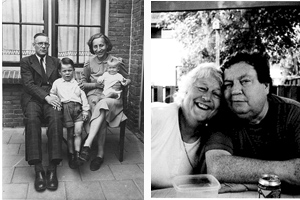
By BERNIE BELLAN Berdina Shorten has lived in Winnipeg since coming here with her family from the Netherlands in 1953. Although Berdina was Jewish by ancestry (going back to her great-grandmother), she hadn’t been raised Jewish. It was only several years after having come to Canada – and having got married, that Berdina – and her late husband, Ken Shorten, both converted to Judaism.
Typically, the stories we publish in this paper about people’s wartime experiences have to do with the Holocaust. Those stories are all certainly horrendous – and almost always riveting, but when I happened to be talking to Berdina about a totally unrelated subject (the renewal of her subscription) and the conversation got around to her wartime experiences, I said to her that I wanted to write about her story.
I should also mention that I had heard Berdina speak at the Shaarey Zedek several years ago, but at that time I didn’t take any notes. (I can’t recall exactly why I was there or how I happened to be in the room when Berdina told her story, but I remember thinking that this would make a great story for the paper some day.)
In any event, here’s a recounting of the first part of Berdina’s story, based on a phone interview that I conducted with her on February .
First, a little history is needed, in order to understand the context for what happened to Berdina and her family.
The German army had invaded Poland in September 1939. After consolidating its gains there, Germany turned its attention to Western Europe in April 1940, first by invading Norway and Denmark, then launching an attack through Belgium into that country, also the Netherlands and Luxembourg (despite those three countries having adopted positions of neutrality).
The German invasion of The Netherlands began on May 10, 1943.
That is where Berdina’s story picks up. But first, a little background on her family history.
Berdina’s father, Theodore (or Theo, as he was known) was a master leather cutter. His “family was Protestant, but his mother was Catholic, so he was raised Catholic,” she said.
As Berdina explained, “his family had come from France in 1610. He used to say the reason his family didn’t go to the New World was ‘no pretty cruise directors, no first class cabins, no air conditioning.’ The real reason was they were Huguenots and they weren’t allowed to go to the New World – unless they went to England and went with the Protestants,” e.g., the Pilgrims on the Mayflower.)
Berdina’s mother (Anna), however, “was born Jewish” but, as Berdina noted, “the family never practiced Judaism. What happened was her mother was born Jewish to a Dutch girl and a German Rhine skipper. Her father died when she was four years old, so her mother went back to Holland, but her family wouldn’t accept her back because she had married someone who was not Jewish. She raised her child (Berdina’s grandmother) with the help of local charities and working in a grocery store.
“When she met my great-grandfather, he was more Catholic than the Pope, so she never practiced her religion and she raised her children as Catholic – but they were actually Jewish – by Jewish law.
“It wasn’t until I was 12 – and I had been sent to Catholic school. I was always challenging the nuns. I wanted to check out Judaism, but I wasn’t allowed.
I asked Berdina whether “she had an awareness that she was Jewish?”
She said she did. “I always knew. My mother knew also, but they hid it.”
I asked then how she knew about her Jewish heritage?
She answered: “My relatives. I heard conversations when I was a child.”
While, Her mother “didn’t practice any religion, her “father did. He’d go to Mass once in a while,” Berdina noted.
When the Germans invaded the Netherlands, Berdina’s father was in the Dutch army, fighting on the “Grebenberg (or the Grebbe line, the main line of Dutch defence)– where they held the Germans back for many days.” (Actually, it wasn’t many days at all – only three. The Dutch were badly equipped and totally outmaneuvered by the Germans.)
Berdina continued her story: “My father was a fantastic shot…But the Queen (Wilhelmina) capitulated. They were bombing the hell out of Rotterdam (May 14, 1940).” The Netherlands surrendered the next day.
Berdina’s father was taken prisoner and sent to work as a forced labourer (in Germany): “So my father was taken and put into a factory. He was a master leather cutter – making shoes.”
Berdina’s family lived very close to the German border with the Netherlands. Thus, even though Theo was forced to work in Germany, it was only a three-hour walk for him to return to his hometown – and his family. It seems somewhat strange to think of someone who’s kept as a forced labourer – which Berdina described as “slave labour”, yet who was allowed to return home on weekends, as she explained:
He was allowed to go home (where mother lived) once a week, Berdina said. “He was given one egg a week, so he would take that egg with him, so my brother (Corey, who was born four years before Berdina) would be able to have at least a little bit of protein in his diet.”
All the while Theodore though, was part of the Dutch underground– meeting with other members of the underground surreptitiously while he was in forced labour for the Germans.
Berdina told this story about one harrowing brush with danger her father had while he was in the resistance: “A story he told was that he was going to a meeting (of the underground) with a friend. They were caught by a young German soldier and the soldier” pointed his rifle at them and “told them to put their hands up. Somehow my father was able to overtake this young soldier.
“His friend said ‘We have to run.’ My father said, ‘No, we can’t. If we run and they find him (the soldier), they’ll kill ten people on this street.“ (That was the retribution the Germans typically exacted, Berdina explained.)
“So my father was able to get a hold of some liquor, put it over the kid’s mouth, then took his guns and papers to the nearest police station, which was controlled by the Germans, and said: ‘One of your soldiers was drunk and we took his guns and papers before he hurt someone.’
“My father was given a pass to go anywhere he wanted that night.”
I asked Berdina if she knew when it was that her father fled the factory for good and ended up going totally “underground” with the Dutch Resistance, but she said she didn’t know exactly when that happened.
When the Canadian army reached Holland in September 1944, anyone who had been in the Dutch army was able to join the Canadian army, Berdina explained, so her father ended up joining the Canadian army.
“When the Dutch army reorganized, he went back to the Dutch army.”
Her father was uncomfortable talking about what he did during the war, Berdina noted, but according to her brother, Theo had once told him that he “had killed at least one German that he knew of (a sniper) and probably more, but he wasn’t sure.”
I asked Berdina whether there were any other memories from the war that she wanted to talk about.
She said there was a young girl – only 14, in her town, “who was the first girl (in Berdina’s home town) to get pregnant by a German soldier.”(That soldier died in a plane crash coming back from North Africa, Berdina added.) “She was also the first girl to get pregnant by a Canadian soldier.
“After the war the people in that community were going to get her and shave her head and send her packing.
“My mother said to my father: ‘That little girl is still only 15 years old. She’s still walking around in Bobby socks and skipping with a skipping rope. Theo (Berdina’s father), could you please do something to stop those people from hurting her?’
“My father went out on to the street and he saw about 50 people coming for the girl. He stopped them.”
In 1953, Berdina, along with her parents and three brothers (two of whom were born after the end of the Second World War), came to Canada.
“My father started to work as leather cutter in the Canada West shoe factory,” Berdina explained.
“Maitland Steinkopf hired him. Eventually my father started to work in St. Boniface Hospital; he’d had a year’s medical training in Edinborough after the war – so he started to work in the hospital, in the x-ray department.
“He worked four hours a night doing piece work for Maitland. He made more money doing that than he did in the hospital.”
I was curious to know more about Maitland Steinkopf and his connection to the shoe business. I knew that Steinkopf was a very successful businessman who also played a leading role in the development of the Centennial Concert Hall, as well as being a prominent Conservative politician and cabinet minister, but other than that I didn’t know much about him.
Berdina said to me that Steinkopf’s success in the shoe manufacturing business was a result of his decision to go to Minneapolis at one point and come back with the Canadian rights to a line of shoes called “Hush Puppies”. That reminded me of another famous decision made by a local Jewish businessman – Samuel Cohen, who decided to begin importing transistor radios made by a company called Sony.
Turning to Berdina’s decision to become Jewish, here is how she explained how that came about:
“My late husband, Ken Shorten (whom I incorrectly referred to as Frank in my previous article), came from an Irish family – that originally came to Canada in 1690, and they farmed in the McCreary area.
“He worked in Eatons – and I worked in Eatons as well. That’s where I met him and we got married.
“Well, he was Protestant and I had been raised in a Catholic environment. We decided that we weren’t going to let the difference in our faiths have a negative effect on us, so we just stuck to ourselves when it came to the religious part.
“But that didn’t work for me and it didn’t work for him and I always knew about my Jewish heritage, so I said to him one day: ‘You know, I’d like to learn more about Judaism; it’s part of my heritage.’ And he said: ‘Me, too.’
“He had some very good Jewish friends at the time (who were all in the NDP). One of them was Cy Gonick, another was Harry Shafransky. He got to know quite a few Jewish politicians. He liked their ethics, liked their values, and so we started to look into Judaism.
“We went to see Rabbi Nesis and (the late) Rabbi Berkal, and we studied with them for two years, and then made the conversion.”
Interestingly, Berdina said that she also spoke with (the late) Rabbi Weizman, who told her that “You can’t convert – you’re already Jewish”.
“But, I said to him, ‘It’s my decision. It’s my journey. I want to do the process.’
“We had two children that we had adopted before we decided to convert – and we brought them in with us.”
I asked when this all happened?
Berdina said the conversion process went from 1973-75.
“We were officially converted in May of ’75,” she said, “and then we were married in the rabbi’s office again.”
“I sang in the Shaarey Zedek choir for 36 years,” Berdina added, “and my son, Theodore, sang in the choir for 20 years…and both kids had their bar and bat mitzvah together.”
“It was the best decision I ever made in my life,” Berdina observed. “It completed me as a human being. I finally fit – because I used to question those nuns. I must have been a real pain in the tuch.”
I asked, “Do you have relatives remaining in Holland?”
Berdina answered: “Yes, I have many.”
I asked, “Are any of them Jewish?”
She answered, “I have one cousin who recognizes himself as Jewish – and that’s it.”
I said to Berdina that what she had told me about her Jewish ancestry and her family’s subsequent conversion to Christianity, it jives with what I had read about how commonplace it was for Jews to have become Christians. I said that I recalled hearing from the late Rabbi Rappaport that only about one-quarter of all Jews in Europe remained Jewish through the years. The rest either converted willingly or by force.
During the course of our conversation, Berdina told me many more stories about her wartime experiences in the Netherlands, all of which were fascinating. Since she was only two years old by war’s end, naturally the stories she tells are one that have been recounted to her by others, but they are all worth retelling.
One that stood out for me in particular was about a Jewish doctor who was kept hidden by his Dutch housekeeper, unbeknownst to anyone else in the town. According to Berdina, when German soldiers came to the house looking for the doctor in 1940, the housekeeper said to them: “I kicked him out long ago when I knew you would be coming. He was miserable to work for and he never paid me enough.”
All through the war that housekeeper was ostracized by her fellow townspeople, as the doctor was universally loved. As Berdina told it, when the town was liberated by Canadian soldiers in 1944, the doctor emerged from the basement – where he had been kept hidden the entire period of occupation by the housekeeper.
Berdina is a great storyteller and when I asked her whether she’d be willing to tell her story to other audiences – as I had heard her do several years ago at the Shaarey Zedek, she readily agreed. If a day comes when Berdina will be able to tell her story to a new audience, I’ll be sure to post something in this paper.
Features
Japanese Straightening/Hair Rebonding at SETS on Corydon

Japanese Straightening is a hair straightening process invented in Japan that has swept America.

Features
History of the Winnipeg Beach Synagogue: 1950-2025

By BERNIE BELLAN The history of the Winnipeg Beach Synagogue is a fascinating one. We have had several articles over the years about the synagogue in The Jewish Post & News.

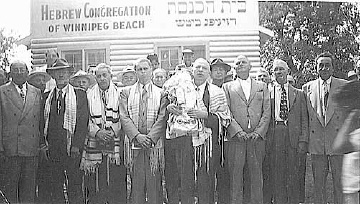
In June 2010 I wrote an article for The Jewish Post & News upon the 60th anniversary of the synagogue’s opening. Here are the opening paragraphs from that article:
“Sixty years ago a group of Winnipeg Beach vacationers decided that what their vacation area lacked was a synagogue. As it happened, a log cabin one-room schoolhouse in the Beausejour area happened to be available.
“In due course, the log cabin was relocated to the corner of Hazel and Grove in Winnipeg Beach, where it stayed for 48 years.”
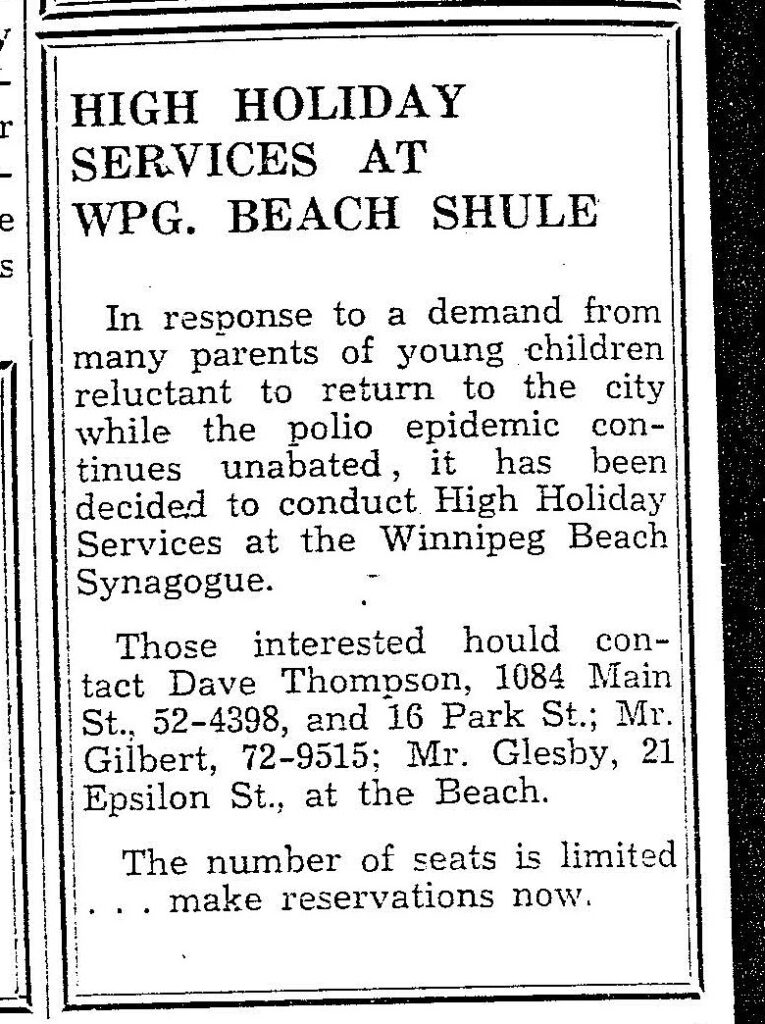
In December 1994 my late brother, Matt, wrote a story about the spraying of antisemitic grafitti on the synagogue which, at that time, was still situated at its original location on the corner of Hazel and Grove in the town of Winnipeg Beach:
“Two 16-year-olds spraypainted slogans like ‘Die Jews,’ ‘I’ll kill you Jews,’ and other grafitti in big letters on the beach synagogue.
“Jim Mosher, a news reporter for the Interlake Spectator in Gimli, said last Halloween’s vandalism against the synagogue wasn’t the first. In the late 1980s, he claimed, it was spraypainted with swastikas.
“Jack Markson, a longtime member of the Winnipeg Beach Synagogue, last week also said he could remember finding anti-Semitic grafitti spraypainted on the synagogue ‘a few years ago,’ and at least twice in the 1970s, when the cottage season was over.”
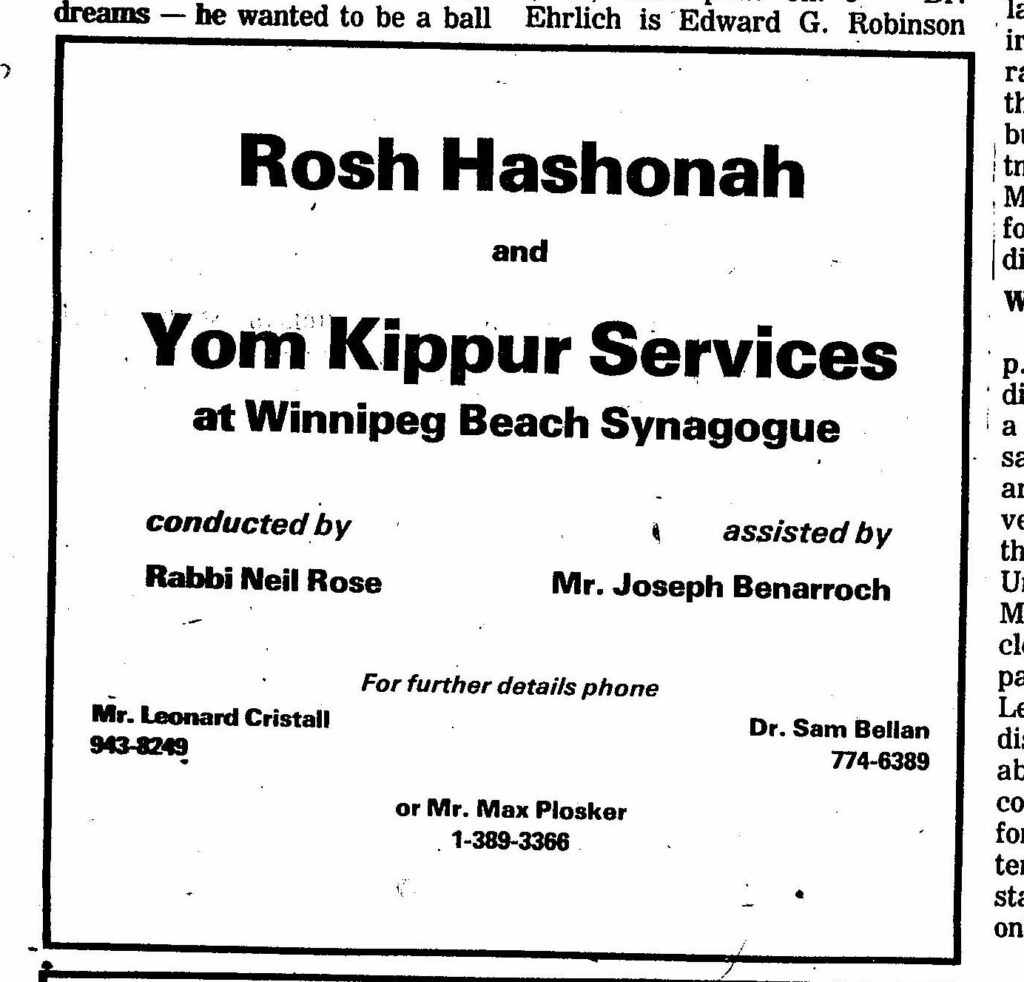
My 2010 article continued: “In 1998 the Town of Winnipeg Beach informed the members of the synagogue that the building would have to be hooked up to the town’s sewer and water system. Rather than incur the cost of $3-4,000, which was thought to be ‘prohibitive,’ according to longtime beach synagogue attendee Laurie Mainster, synagogue goers looked elsewhere for a solution.
“As a result, the board of Camp Massad was approached and asked whether the synagogue might be relocated there, with the understanding that the synagogue would be made available to the camp at any time other than what were then Friday evening and Saturday morning services.
“Over the years the ‘beach synagogue’ had come to be a very popular meeting place for summertime residents of Winnipeg Beach and Gimli. In fact, for years minyans were held twice daily, in addition to regular Saturday morning services. Of course, in those years Winnipeg Beach was also home to a kosher butcher shop.
“While the little synagogue, which measured only 18 x 24 feet, has gone through several transformations, including the move to Camp Massad, and the opening up to egalitarian services in 2007 (The move to egalitarian services was as much a practical necessity as it was a nod to the equality of women – the only Kohen present at the time was a woman!), it has always remained cramped at the best of times.
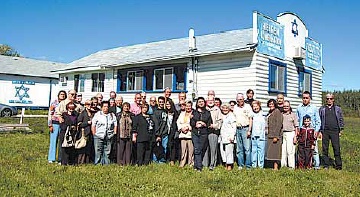
“In recent years the synagogue has seen the addition of a window airconditioner (although to benefit from it, you really have to be sitting just a few feet away), as well as a fridge that allows synagogue attendees to enjoy a regular Saturday morning Kiddush meal following the service.
“According to Laurie Mainster, the Saturday morning service has continued to be popular, even though many of the attendees now drive in from Winnipeg, as they have sold the cottages they once maintained.
“On the other hand, one of the side benefits to being located on Camp Massad’s grounds has been an infusion of young blood from among the camp counsellors.
“Since there is no longer a rabbi available to conduct services (Rabbi Weizman did lead services for years while he had a cottage at the beach), those in attendance now take turns leading the services themselves.
“Anyone may attend services and, while there are no dues collected, donations are welcome. (Donations should be made to the Jewish Foundation of Manitoba, with donors asked to specify that their donations are to be directed to the beach synagogue.)
“Mainster also says that the beach synagogue is now undergoing an expansion, which will be its first in 60 years. An entirely new space measuring 16 x 18 feet is being added – one that will allow for a real Kiddush area. (Until now, a table has been set up in the back of the synagogue and synagogue goers would help themselves to the buffet that is set up each Saturday during the summer. While pleasant enough, it will certainly be more comfortable to have an actual area set aside for the Saturday afternoon after service lunch.)
“As for dress, longtime attendee Abe Borzykowski (in an article written by Sharon Chisvin for the Free Press in 2007) remarked that ‘I don’t think there are many synagogues where people can attend in shorts, T-shirts and sandals and not feel out of place.’ “

As mentioned in that 2010 article, the beach synagogue at that time was about to undergo an extensive remodelling. Here is an article from a January 2011 issue that describes that remodelling process. The article was written by Bernie Sucharov, who has been a longtime member of the beach synagogue:
“The Hebrew Congregation of Winnipeg Beach made a major change to the synagogue this past summer. With the help of many volunteers, Joel Margolese being the project manager, the synagogue was expanded and an addition was built to handle the overflow crowds, as well as to add more space for the kiddush following services.
“The volunteers spent many Sundays during the summer months building the addition. Bad weather caused many delays, but finally the addition was completed one week before the official summer opening.
“The volunteers were: Joel Margolese, Gordon Steindel, Sheldon Koslovsky, Viktor Lewin, Harvey Zabenskie, Nestor Wowryk, Kevin Wowryk, Victor Spigelman, Jerry Pritchard, and David Bloomfield.
“On Sunday, June 25, 2010 a special ceremony was held to affix a mezzuzah to the front entrance door. Gordon Steindel had the honour of affixing the mezzuzah, which was donated by Sid Bercovich and Clarice Silver.
“Refreshments and food for the day were prepared by Phyllis Spigelman, also known as our catering manager. Throughout the summer, Phyllis, Lenore Kagan and other friends prepared the food for our kiddush.
“A sound system was donated by Arch and Brenda Honigman in memory of their father, Sam Honigman z”l. “The system was installed by Joel Margolese and Stevan Sucharov. This will allow the overflow crowd to hear the service in the new addition.
“There were also generous donations of 50 chumashim and an air conditioner. The chumashim were donated by Gwen, Sheldon and Mark Koslovsky. The air conditioner in the new addition was donated by Joel and Linda Margolese.
“The official opening of the synagogue for the summer took place on July 3, 2010. We had an overflow crowd of 70+ people.”
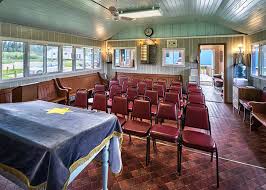
Since that 2010 major addition to the synagogue, it has also added a wheelchair ramp (although I’ve been unable to ascertain exactly when the ramp was built). Also, the synagogue also has its own outdoor privy now. (Attendees used to have to use facilities in Camp Massad.)
And, as already noted in article previously posted to this site (and which you can read at Beach Synagogue about to celebrate 75th anniversary), in recognition of that occasion, on August 2nd members of the synagogue will be holding a 75th anniversary celebration.
As part of the celebration anyone who is a descendant or relative of any of the original members of the first executive committee is invited to attend the synagogue that morning.
If you are a relative please contact Abe Borzykowski at wpgbeachshule@shaw.ca or aborzykowski@shaw.ca to let Abe know you might be attending.
Features
Kinzey Posen: CBC Winnipeg’s former “go-to guy”

By GERRY POSNER If former Winnipegger Lawrence Wall was the CBC go-to guy in Ottawa, CBC Winnipeg had its own version of a go-to guy for many years with none other than the very well known Kinzey Posen. Of course, many readers will recognize that name from his career with Finjan, the Klezmer group so famous across Canada and beyond. It has been written about Posen and his wife Shayla Fink that they have been involved in music since they got out of diapers. And, as an aside, their love and ability in music has now been transmitted to the next generation as in their son, Ariel Posen (but that’s another story).
Kinzey Posen (not to be confused with Posner, or maybe we are to be confused, but who knows for sure?), was a graduate of Peretz School, having attended there from nursery right until Grade 7, graduating in1966. That was followed by Edmund Partridge and West Kildonan Collegiate. Musically, he was in large part self taught. However, he did have some teachers along the way. After moving to Vancouver – from 1974-78, he had the chance to study acoustic classical bass with a member of the Vancouver Symphony Orchestra. When Kinzey lived in Vancouver, he also worked as a jazz musician.
Upon returning to Winnipeg, Kinzey enrolled as a mature student at the University of Winnipeg, where he obtained a Bachelor of Urban Studies degree. Although the degree was in no way connected to the career that followed, his attending the University of Winnipeg was critical to his connecting with the CBC. Why? you ask. Kinzey had a position after graduation working for the Institute of Urban Studies. While there, he met someone who invited him to work for the Department of Continuing Education as one of their program directors. At the time the Department of Continuing Education was located at 491 Portage Avenue, which was also known as the TJ Rice Building. The CBC also leased some space in the same building. According to Kinzey, the CBC part of the building “included HR, different shows and other support offices. Continuing Education was located in the basement and main floor and that’s where I worked.”
KInzey had long had an interest in the CBC, which made the fact that the CBC had some offices in the same building where he was working serendipitous. That Kinzey might be interested in visiting the CBC was not an accident. As a young boy he had a nightly connection to CBC, as it was his ritual to listen to CBC Radio (as well as all sorts of other radio stations across the USA) on his transistor radio every night in bed. He became enamoured of one particular CBC host, Bill Guest, so that when going to sleep, he imagined that he was Guest doing interviews with imaginary guests. That dream of working for CBC became a reality when he had a chance to do a one week gig with Jack Farr’s network program.
Kinzey took a week off from his Continuing Education job and spent five days at the CBC. That week was a training session for Posen, as he had to create ideas, research, pre-interview, write the script, and set up the studio for Farr’s interview. He was almost in his dream job – although not quite – since it was only for one week. His opportunity, however, came in 1988, when he was offered a one-year term as a production assistant – the lowest guy on the ladder, for a show called “ Simply Folk,” with the late Mitch Podolak as the host. Although he was indeed at the bottom as far as those working on the show were concerned, he took a chance and gave his notice to the U of W. The rest is history. In his new job, Kinzey learned how to become a producer. Lucky for him, at the end of the year, when the person he replaced was supposed to come back, she never returned (just like the song, “MTA,” by the Kingston Trio). At that point, Kinzey was hired full time at the CBC.
Kinzey was a fixture at the CBC for 27 years. During those years, Kinzey had the chance to work with Ross Porter, a respected former CBC host and producer, also with Karen Sanders – on the “Afternoon Edition.” One aspect of Kinzey’s job on the Afternoon Edition was to come up with ideas, mix sound effects, arrange interviews and music, to create a two-hour radio experience. In addition, he covered jazz and folk festivals and, as a result, was exposed to some of the best musicians in the world. With Ross Porter in the 1990s, he worked on a network jazz show called “ After Hours,” which was on from 8-10 PM five nights a week. Kinzey was involved with writing the scripts, picking the music, and recording the shows, as well as editing them and then presenting them to the network for playback.
Of course, over his career, Kinzey had many memorable moments. He told me about one of them. The story revolved around the National Jazz Awards one year in particular. The awards were to be broadcasted after the National News which, in those days, began much earlier in the evening, and were over by 8:00 pm. The legendary Oscar Peterson was lined up to play a half hour set at the awards, starting at 7:30. But, as Kinzey told me, Oscar Peterson had a “hate on” for the CBC ecause one of his recorded performances was wrongly edited and he refused to appear on CBC under any circumstances. As the time neared 8:05 PM, which was when the CBC was to begin its broadcast of the jazz awards, it became apparent that Oscar was not going to finish on time. As the producer of the awards show, Kinzey was tasked with telling Oscar Peterson to wrap it up and get off the stage. There was Kinzey Posen, a huge fan of Oscar Peterson, now faced with the prospect of telling Oscar – while he was still playing – with 500 people in the audience, to stop and get off the stage. Not often was or is Kinzey Posen frozen, but that was one such moment. There was one loud “Baruch Hashem” from Kinzey when Oscar completed his set literally just in time.
Clearly, Kinzey was part of a very successful run with After Hours as it was on the air for 14 years. It was easily one of the most popular shows on CBC Radio 2, and a winner of several broadcasting awards. Kinzey also played a major role in producing a two part documentary about legendary guitarist Lenny Breau.
When After Hours ended, Posen became one of the contributing producers to Canada Live and specialized in producing live radio specials for the network, such as the Junos, for CBC Radio One and Two. Needless to say, his career planted Posen in the world of some top notch musicians, including his time spent working with Robert Plant (Led Zeppelin), Dave Brubeck, Randy Bachman, Chantal Kreviazuk and a list of prominent names in the Canadian, American and European music spheres. Locally, the CBC came to refer to Kinzey as the Jewish expert. I would add music expert to that title.
After his 27 year run at the CBC – and before he fully retired, Kinzey went on to work for the Rady JCC as a program director for a year and a half. Of course, to say that Kinzey Posen is retired is a major contradiction in terms. You really can’t keep him down and he has his hand in a variety of programs and projects – most of which he remains silent about, as is his style.
When I realized the full depth and talent of Kinzey Posen, I quickly concluded that he must certainly be related to me. Even if he isn’t, I now tell people he is.
